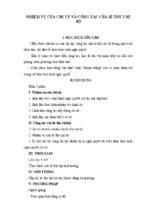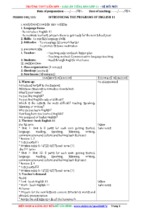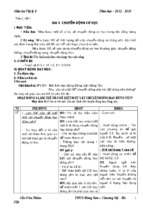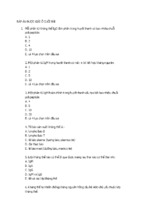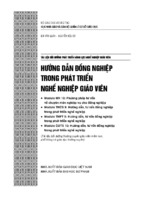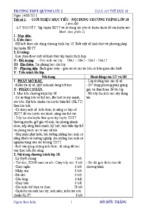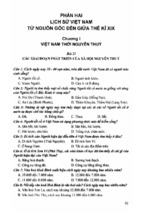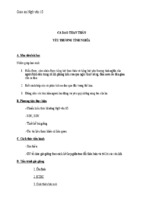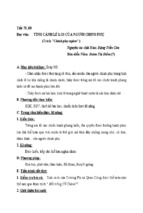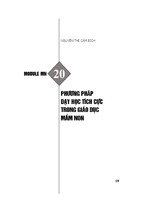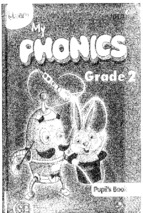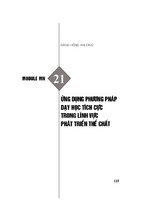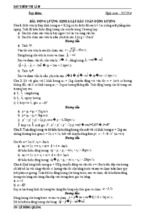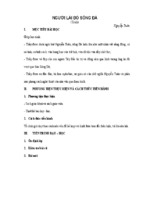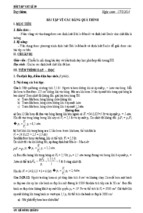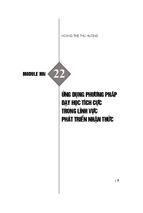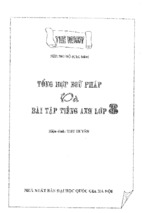Date: 20/8/2014
Period: 1
Introduction
Chương trình, phương pháp và yêu cầu đối với sách tiếng Anh 11 nâng cao
I. AIMS:
Thông qua tiết học này học sinh hiểu khái quát về cấu trúc chương trình tiếng Anh 11 nâng
cao, nắm được phương pháp học và những yêu cầu phải đạt được sau khi học xong chương trình
này.
II. PROCEDURES:
Content:
A. Giíi thiÖu ch¬ng tr×nh TiÕng anh 11:
- Gåm 16 ®¬n vÞ bµi häc (Unit) vµ 4 bµi «n tËp (Consolidation).
- Mçi bµi häc ®îc biªn so¹n theo 1 chñ ®Ò nhÊt ®Þnh ®îc chia lµm 5 phÇn , mçi phÇn lµ 1 kü n¨ng
( ®äc, nghe, nãi, viÕt vµ language focus).
- Mçi bµi «n tËp gåm: pronunciation; Listening comprehension; Vocabulary; Grammar and structure;
Reading and writing.
B. Yªu cÇu m«n häc:
Mçi h/s ph¶i cã ®ñ SGK (English 11) s¸ch míi do NXB Gi¸o dôc ph¸t hµnh.
Mçi h/s ph¶i cã 02 quyÓn vë ( ghi chÐp vµ chuÈn bÞ bµi ë nhµ )
Tríc khi ®Õn líp h/s ph¶i chuÈn bÞ bµi ë nhµ theo yªu cÇu tõng phÇn (Tasks) vµ lµm bµi tËp theo y/c
cña
gi¸o viªn
Trong líp h/s ph¶i tÝch cùc tham gia c¸c ho¹t ®éng theo cÆp, theo nhãm díi sù híng dÉn cña gi¸o
viªn.
Nªu c©u hái th¾c m¾c yªu cÇu gi¸o viªn gi¶i ®¸p (nÕu cã).
Tãm l¹i : §Ó häc tËp cã kÕt qu¶ mçi h/s sinh cÇn ph¸t huy tÝnh tÝch cùc , tÝnh chñ ®éng, tù gi¸c
trong ho¹t
®éng häc tËp , kh«ng tr«ng chê û n¹i. Gi¸o viªn chØ ®ãng vai trß lµ ngêi tæ chøc ho¹t ®éng , híng
dÉn , gi¶i
®¸p th¾c m¾c , gióp ®ì khi h/s gÆp khã kh¨n.
3. Remind:
+ Prepare for Unit 1: Reading part.
.
The end
Date: 20/8/2014
Period: 2
UNIT 1: friendship
READING (1)
A, AIMS:
- Students can express their opinions about friendship.
- Reading for gist and for specific information.
1
B, OBJECTIVES:
* By the end of this lesson, Students will able to:
- Develop such reading micro-skills as scanning for specific ideas, skimming for general
information, and guessing meaning in context.
- Use the information they have read to express their ideas about friendship.
C, TEACHING AIDS:
- Text book, handouts, pictures, chalk and board
D, METHOD:
- Integrated, mainly communicative.
E, PROCEDURES:
Stages Teacher’s Activities
-Warm
up and
lead-in
(8mins)
Students’ Activities
*T asks students some questions:
-Do you have friends?
-What is a good friend like, according to you?
Transition: In to day reading, we’ll get to know
more about friends and friendship.
- Listen to teacher and work in
groups and answer.
-Write on note book carefully
*Teaching Vocabulary
Prereading
(20mins)
-To provide Ss’s with some language to help
them understand the text.
-To help enrich Ss knowledge of vocabulary.
*Elicit meanings from Ss or give explanations
your self .
-break out in to tears (v)=begin to cry
-through thick and thin (idm)=in spite of all the
difficulties (trong bÊt cø hoµn c¶nh nµo)
-cheat (v)=copy sb’s work in a test
-detention (n)=punishment of being kept at
school after it has closed (h×nh ph¹t giam ë trêng
sau giê häc)
-confide in sb (v)=trust sb enough to tell a secret
to him/her (t©m sù, thæ lé)
-guarantee (n)=sù ®¶m b¶o
-elvolve (v)=develop naturally and gradually
-stick together(v)=remain friendly and loyal to
one another
(g¾n bã)
-Listen and read after to T
-Read the text carefully then discuss
in pairs
-Work in groups and know how to
use them in a new context.
-Write on note book carefully
-Work in pairs.
*Give some practice on pronunciation (Read-Ss
repeat)
*Checking Vocabulary: GAP-FILLING
(10mins)
-Give Ss handouts and ask them to work in pairs,
completing the sentences, using the words just
learned
1, A good friend remains loyal to you............
2, Blue skies are not a..........of continuing fine
weather.
3, Being scolded by his mother, the child............
4, Those students were sent to the........room for
their cheating on the exam.
5, Like friendship, trust........with time.
6, Ann thinks there’s no one in the class she
2
-Work in pairs.
-Expected answer:
1, through thick and thin
2, guarantee
3, broke out into tears
4, detention
5, evolves
6, confide in
can.......... .
3, Consolidation: (2mins)
-The content
4, Home work: (3mins)
-Writing: Sentence building
-Give Ss handouts, and ask them to make sentences using the cues.
1, your ideas/ good friend/ different/ different grades//
2, best friend/ someone/ you can confide//
3, best friends/ usually stick together/ thick/ thin//
4, best friend/ help you/ avoid/ depression/ anxiety//
-Expected answers:
1, Your ideas of a good friend are different in different grades.
2, A best friend is someone you can confide in.
3, Best friends usually stick together through thick and thin.
4, A best friend can help you avoid depression and anxiety.
Date: 21/8/2014
Period: 3
UNIT 1: friendship
READING (2)
A, AIMS:
- Students can express their opinions about friendship and do all exercises.
- Reading for gist and for specific information.
B, OBJECTIVES:
* By the end of this lesson, Students will able to:
- Develop such reading micro-skills as scanning for specific ideas, skimming for general
information, and guessing meaning in context.
- Use the information they have read to express their ideas about friendship.
C, TEACHING AIDS:
- Text book, handouts, pictures, chalk and board
D, METHOD:
- Integrated, mainly communicative.
E, PROCEDURES:
Stages Teacher’s Activities
Students’ Activities
Activity 1: -Reading and matching (Task a p:16)
Whilereading
(8mins)
(*To develop Ss’ skimming skills)
-Work individuals
-Ask Ss to read Text A and then match the grades with
John’s opinions on what a good friend is.
-Call on Ss to say what John thought of a good friend
in each grade.
-Go over the answers with the class
-Complete and present before
the class.
3
Activity 2: -True-False Statement (Task b p:16)
(To give some personalized task to engage Ss)
(10mins)
-Ask Ss to read the statements about close friends in
Task b (p.16) and say if they are true or false, i. e, Ss
agree or disagree with them.
-Check with be class and note down on the board Ss’
opinions.
-Tell Ss to read Text B and decide if the statements are
true or false.
-Ask ss to work with a partner and compare answers
-Call on Ss to read the statements and say their choice.
-Go over the answer with the class.
-Tell Ss to compare the ideas in the text and Ss
opinions.
-Work individuals
-Work in pairs then whole class.
Answer:
1, T
2, F (According to the text, we
become friend with those who
share common interests)
3, F (We can’t go out and pick a
good friend)
4, T
5, T
Activity 3: -Main ideas
(10mins)
(To provide practice on skimming for general ideas)
-Write down on the board three phrases about main
-Work individuals then compare
ideas of the paragraphs in Text B and one extra phrase. with your partner
a, possible reasons for not having a best friend
b, what to do to have a best friend
c, how best friendship develops
d, the benefits of a best friend/what a best friend can
do to us
-Ask Ss to skim the text again and match the
paragraphs with a partner
-Go over the answers with the class.
-Discussion:
(To provide Ss with some free practice and to have
them express themselves and share ideas)
Postreading
(12mins)
-Ask Ss to work in groups of 4 or 5, expressing their
opinions on the following questions:
a, Close friends don’t need to share common interests.
Agree or disagree? Give reasons.
b, What is your own idea of a good friend?
c, How do you understand the proverb “A friend in
need is a friend indeed”?
-Go around to control and give help if necessary.
-Call Ss to report about their groups’ ideas.
-Give feedback and comments on what Ss have
-Work in pairs discuss then
present.
-Expected answers:
-Par.1 - d
-Par.2 - c
-Par.3 – a
-Work in groups :
-Do as required
-Discuss and then present before
the class
-Give comments.
3, Consolidation: (1min)
-The content
4, Home work: (2mins)
-Do ex 1-2 (p.11-12) in English Ex Advanced (Pa. Reading)
4
Date: 26/8/2014
Period: 4
UNIT 1: friendship
listening
A. Aims:
- Students should understand more about the friendship and practice listening skill.
- Listening for gist and for specific information.
B, OBJECTIVES:
* By the end of this lesson, Students will able to:
- Listen and pick up specific details and understand general ideas.
C, TEACHING AIDS:
- Text book, CD player, cards, sheets of paper, chalk and board
D, METHOD:
- Integrated, mainly communicative.
E, PROCEDURES:
stages Teacher’s Activities
Students’ Activities
*To create interest, review adjectives and nouns and
introduce the topic.
Game: -“Five little things”
Warm-up
(5mins)
-Ask Ss to work in groups of 4.
-Tell Ss to listen to instructions and write down 5
things as required on a piece of paper.
-The group that finishes first and gets all correct
will get 1 point.
-The group that has more points will win the game.
-Check Ss’ understanding of instructions and have
them start the game.
*These are the suggested instructions:
1, Write down 5 places where you often meet with
your close friend.
2, Write down 5 things you often share with your
close friend.
3, Write down 5 qualities you need in a good
friend.
4, Write down 5 adjectives describing appearance.
5, Write down 5 adjectives describing character of
personality.
-Read Ss’ items and check with the class after each
question
-Declare the winner
-Transition: - Today we use a lot of nouns and
adjectives to talk about friend. Today we will listen
to a letter from Jack, writing about his new friend.
Teaching Vocabulary
Pre-
*Use pictures and explanations to present some
new words and then read the words one by one and
5
-Listen to teacher and work in
groups
-Discuss and present before the
class.
-Expected answers:
1, home, school, park, cinema,
evening class...
2, notes, cake, homework, school
things, joy, sadness....
3, honesty, loyalty, unselfishness,
helpfulness, good-heartedness...
4, tall, short, good-looking,
beautiful, well-dressed, stout....
5, reserved, going out, sociable,
studious, sympathetic....
-Listen, understand and write on
note book carefully
listening
(5mins)
ask Ss to repeat:
-sociable (a)=friendly, outgoing
- conservative (a)=opposed to great change (b¶o
thñ)
-sensitive (a)=easily offended, easily hurt (nh¹y
c¶m)
-skinny (a)= very very thin (gÇy tr¬ x¬ng)
-stout (a)=rather fat
-indifferent (a)=having no interest (thê ¬)
Checking Vocabulary
(3mins)
-Tell Ss to listen to the explanations in English and
say the word.
1, very thin
2, having no interest
3, friendly, outgoing
4, easily offended
5, rather fat
6, opposed to great change
*Describing Yourself (Task a, p.17)
(3mins)
-Ask Ss to read the list of adjectives and tick(v) the
words that describe them and add more adjectives
that are true for them
-Call on one student or two to read their list that
describes themselves.
Activity 1: -Listen and tick (v) (Task b, p.17)
Whilelistening
(5mins)
-Tell Ss they are going to listen to a letter from
Jack, writing about his new Vietnamese friend,
Mai.
-Ask Ss to listen and tick (v) what is true about her.
-Let Ss listen for the second time id necessary
-Go over the answers with the class.
Activity 2: -Listen and take notes.
(5mins)
-Ask Ss to listen again and note down the noun
phrases used to describe Mai’s appearance.
-Call on Ss to read their notes and check with the
class.
-Check with the class
Activity 3: -Questions and answers:
-Tell Ss to listen again and answer the questions.
(7mins)
1, On what occasion did Jack meet Mai Tran?
2, How old are Jack and Sinh?
3, What do Mai, Jack and Sinh have in common?
4, Where is Mai going this summer?
5, Will Jack go with Mai there?
-Listen to teacher then read in
chorus
-Understand all meaning of new
words and how to use.
-Listen carefully and give
Expected answers:
1, skinny
2, indifferent
3, sociable
4, sensitive
5, stout
6, conservative
-Do as required
-Do as required
-Work individuals
*Give the expected answers:
-her rosy plump face
-two dimples (on her cheeks)
-short hair, and
-casual clothes
*T-class
-Expected answers:
1, Jack met Mai Tran at his
cousin’s party
2, They are 17-the same age as
Mai
3, They all have the same taste in
information technology and music
4, She’s going to visit/ travel back
to Vietnam
5, Maybe, He hasn’t decided yet.
-Listen to teacher, work in pairs
then present before the class
Speaking: -Role play (Handout)
-Comments and then give
6
Postlistening
(8mins)
-Pair of Ss as A and B and tell A to play the role of
Jack and B the role of Sinh. Ss imagine they are
having a conversation on the phone.
-Give each student a role card (Appendix) and ask
them to make a conversation based on the ideals
suggested.
-Move around to control and give help if necessary.
feedback
(-If time allows, have 1 or 2 pairs to act out their
conversations in front of the class)
3, Consolidation: (1min)
-The content.
4, Home work:
-Tell Ss to learn the new words and make some sentences with
them, describing a certain person.
Date: 27/8/2014
Period: 5
(1min)
UNIT 1: friendship
SPEAKING
A, AIMS:
- Students should know how to practice speaking skill.
- Speaking for gist and for specific information.
B, OBJECTIVES:
* By the end of this lesson, Students will able to:
-Introduce themselves and know how to make friends with someone new.
-Describe the physical characteristics and personalities of their friends using
appropriate adjectives
C, TEACHING AIDS:
- Text book, handouts, pictures, chalk and board, porters....
D, METHOD:
- Integrated, mainly communicative.
E, PROCEDURES:
Stages Teacher’s Activities
Students’ Activities
*Give some question for Ss:
Warm-up
(5mins)
-What is your own idea of a good friend?
-Work in groups-discuss and
present before the class.
7
-How do you understand the proverb “A good
friend is a friend indeed?”
Prespeaking
(8mins)
-Ask Ss: -What do you do/ say to make friends
with someone new?
-Note Ss’ ideas on the board
-Tell Ss to read the expressions in Task a(p.18) and
tick (v) the ones that they can use to start a
conservation.
-T-class
-Expected answers:
2, 3, 4, 5, 6, 7 and 8
Whilespeaking
(10mins)
Activity 1: Completing &Practising the Dialogues
(Task b. pp18-19)
-Tell Ss to complete the dialogues in Task b (p.1819) and then compare with a partner.
-Check with the class by calling 2 pairs to act out
the conversations.
-Tell Ss to work in pairs and act out the
conservations
-Call on some close and open pairs to act out
-Expected answers:
(10mins)
Activity 2: -Role-play
-Work in pairs:
1, I’m
2, Try/ Have
3, It’s good/ It tastes good
4, isn’t it/ doesn’t it
5, Would you like../ Could I get
you..
6, It’s..
7, isn’t it
8, Have I met..
9, at..
-Prepare sets of 4 personal information cards.
-Ask SS to work in groups of 4
-Give each group a set of 4 cards and tells SS they
are now the person described on the card and they
are at a multi-school party. Ss practice making
friends with the other people in their groups.
-Go around to control and give help if necessary
-Call on some Ss to the front of the class to act
about the conversations
-Give comments
Questions and Answers:
Postspeaking
(8mins)
-Ask Ss work in pairs and practice making some
conversations then answers the questions
-Go around to control and give help if necessary
-Call on Ss to stand up and practice
-a, Who are they?
-b, What are they doing?
...................................................
-Give feedback and comments on what Ss have
-Go over the answers with the class
-Work in groups.
-Do as required
-Listen to teacher and work in pairs
-Practice once more and then
present their conversations before
the class
-a, They are.....................
-b, They are introducing
themselves/ making
friend.....................
3, Consolidation:
(1min)
-The content.
4, Homework :
(1min)
-Ask Ss to review the expressions used to start a conversation
8
Date: 27/8/2014
Period: 6
UNIT 1: friendship
WRITING
A, AIMS:
- Students should know how to practice writing skill, how to write a narrative and can write a
narrative about one of their friends.
- Writing for gist and for specific information.
B, OBJECTIVES:
* By the end of this lesson, Students will able to:
-Describe a friend.
-Write a narrative
C, TEACHING AIDS:
- Text book, handouts, pictures, chalk and board, sheets of paper....
D, METHOD:
- Integrated, mainly communicative.
E, PROCEDURES:
Stages Teacher’s Activities
Students’ Activities
Game: -Memory check
-Hang a poster with descriptive adjectives on the
Warm-up board.
(5mins)
-Tell Ss to look at the words for a few seconds,
try to remember them.
-Put the poster away and ask Ss to write down as
many words they can remember as possible. The
student will the most words listed wins the game
*These are the adjectives:
tall
beautiful
kind smart timid
handsome
short pretty thin black
curly long shy
straight
slim
-Ask the student how she/ he can remember so
many words
-Tell Ss if they put things under some
classifications, it’s easier to remember them.
-Ask Ss to put the adjectives under three
headings of Hair/ Face, Build and Opinion.
9
-Listen to teacher and understand how
to practice.
-Work individuals
-Do as required
-Expected answers:
*Hair/ Face : -long, black, curly,
straight
*Build: -tall, slim, short, thin
*Opinion: -beautiful, pretty, kind,
Prewriting
(5mins)
Teaching Vocabulary
-Elicit the meanings of new words from Ss or
give explanations yourself.
-vicious (a)=acting with evil intentions; spiteful
(xÊu xa, nham hiÓm)
-imbecile (n)=stupid or silly person; fool (kÎ
ngèc, ngêi khê kh¹o)
-smart (a)=clever; intelligent
-criticize (v)=point out the faults of sb/ st (chØ
chÝch, phª b×nh ai)
-confress (v)=admit (thó nhËn)
-giggle (v)=laugh lightly in a nervous or silly
way (cêi róc rÝch)
-Read the words one by one and ask Ss to repeat.
(5mins)
Activity 1: -Gap-filling (Task a, p.20)
-Ask Ss to read the passage and fill in each gap
with a suitable word from the box.
-When they have finished, tell Ss to work with a
partner and compare answers.
-Call on some Ss to read their completed
sentences and check with the class.
handsome, timid, shy, smart.
-Listen to teacher
-Write on note book carefully
-Read in silent then read in chorus
-Repeat once more
-Work individual then compare with
the partner and present before the class
-Work individuals
-Do as required
-Listen to teacher and do as required
(5mins)
Activity 2: -Re-ordering (Task b p.p.20-21)
-Ask Ss to work in pairs, reading the sentences
and putting them in the logical order of a
narrative.
-Call on Ss to read the sentences in the order
they arrange and check with the class
Expected answers:
(5mins)
Activity 3: Questions and Answers:
-Make questions about the narrative in Task b
and ask Ss to find answers to the questions.
a, When and where did the writer meet Trang?
b, What was she like?
c, What did they have in common?
d, How do they keep in touch?
Whilewriting
(12mins)
Writing a narrative
-Ask Ss to write a short narrative about a friend
of their based on the ideas suggested and the
samples in Task a and b
-Go round to control and give help if necessary
-When they have finished, collect Ss’ writings
Postwriting
(4mins)
-Peer correction
*Ask Ss work in groups and tell them read and
correct their friends narratives
-Go around to control and give help if necessary
-Ask Ss read their group’s best writing and ask
Ss to give comment.
Give feedback and comments.
-Work individuals
a, At his cousin’s birthday party, two
years ago
b, She had a cheerful face and 2
dimples; she looked athletic in jean
and a T-shirt
c, They were both interested in chess
d, though e-mails
-Look at the book and practice writing
a short narrative about one of your
friend
-Do as required
-Work in groups and do as require
-Give comments.
3, Consolidation :
(1min)
-The content.
4, Homework:
(1min)
-Ask Ss to underline all the adjectives used to describe Trang
in Task b
-Rewrite their writing on notebook carefully.
10
Date: 28/8/2014
Period: 7
UNIT 1: friendship
LANGUAGE FOCUS (1)
A, AIMS:
- Students should know how to practice Descriptive adjectives.
- Ss can practice by doing exercises correctly.
B, OBJECTIVES:
* By the end of this lesson, Students will able to:
- Use descriptive adjectives
- Different verb forms in a narrative
C, TEACHING AIDS:
- Text book, handouts, pictures, chalk and board, ....
D, METHOD:
- Integrated, mainly communicative.
E, PROCEDURES:
Stages
Warm-up
(8mins)
Teacher’s Activities
Students’ Activities
-Divide the class into 4 groups and ask Ss
write down 10 adjectives describing character
of personality. The winner will be the group
completing the task in the shortest period of
time.
-Listen to teacher and work in group
-Discuss and complete
**Help Ss understand how to use Des..Adjs.
Word
study
(5mins)
Descriptive adjectives:
-Descriptive adjs or adjs of quality include
those of size, shape, age, type, colour,
material, origin, purpose and opinion (or
general description).
-The positions of descriptive adjs are:
attribute (before the noun) and predicative
( after a verb such as be, become, get, seem,
feel, look.....)
(10mins)
Activity 1: Underlining the Adjectives.(T.a
P.21)
- Tell Ss to read the sentences and underline
the adjectives.
-Go over the answers with the class.
(8ms)
Activity 2: Gap-filling (Task b p.22)
-Help Ss with the meanings of some new
words.
-persistent (a)=continuing without
interruption ( dai d¼ng)
-bushy (n)=covered with bushes (rËm r¹p)
-piercing (a)=( of sounds) penetrating (the
thÐ, ®inh tai)
-phobia (v)=extreme dislike or fear of (sth)
(sù ¸m ¶nh, sî h·i mét c¸ch v« lý)
(10mins)
-Tell Ss to read and complete the passage
using the words given.
-Go over the answers with the class.
Activity 3: Jumble sentences ( Task c p.22)
11
-Listen to teacher, understand and
write on note book carefully.
-Work individuals
-Discuss and compare with your
partner than one or two Ss present
before the class.
-Give comments.
-Work individuals
-Listen and understanding all new
words and meaning.
-Discuss and compare with your
partner.
-Give comments.
-Work individuals.
-Read the example and ask Ss to pay attention
to the position of the adjectives.
-Ask Ss to rearrange the words to make
meaningful sentences and then compare with
a partner.
3, Consolidation :
(1min)
4, Homework:
(1min)
language- P.13-14)
Date: 3/9/2014
Period: 8
-Discuss and compare with your
partner then present before the class.
-Give comments
-Write on note book carefully
-The content.
-Ask Ss to do Ex in Advanced English Exercise (Past .Use of
-Redo all exercises.
UNIT 1: friendship
LANGUAGE FOCUS (2)
A, AIMS:
- Students should know how to practice grammar-based (verbs form, linking words)
- Ss can practice by doing exercises correctly.
B, OBJECTIVES:
* By the end of this lesson, Students will able to:
- Use descriptive adjectives
- Different verb forms in a narrative
C, TEACHING AIDS:
- Text book, handouts, pictures, chalk and board, ....
D, METHOD:
- Integrated, mainly communicative.
E, PROCEDURES:
12
Stages
Teacher’s Activities
Students’ Activities
Verb from review (pp.22-23)
Grammar
(18mins)
-Elicit from Ss the tense used in a narrative. (Ex
Past Simple, past continuous and past perfect)
-Ask Ss to compare these sentences (Ex: The past
simple is used for the actions in the story, to tell us
what happened next. The past continuous is used
for sth around a past time or together with the past
simple when a shorter action comes in he middle
of a longer one.)
-Listen to teacher, understanding
how to use past simple, past
continuous and past perfect)
-Give examples
*Work individuals
-Discuss and compare with your
partner then present before the
class.
-Tell Ss to read and complete the passage using the -Give comments
words given.
-Write on note book carefully
-Go over the answers with the class.
Linking word: (p.23)
(10mins)
-Match one line in column A with one in column
B.......
-Ask Ss look at their book and practice by doing
Ex.
-Call Ss work individuals then read their sentences
and check with the class
-Go over the answers with the class
*Work individuals
-Do as required
Expected word:
1, and + e
2, or + c
3, but + d
4, either + b
5, Neither + a
FURTHER PRACTICE
(12mins)
-Give Ss a handout with the linking words in
column A and the meanings in column B. Then
*Work individuals
ask them to match the linking words with their
suitable meanings.
-and=also; then, following this
( used to connect words of the same
part of speech, phrases and clauses)
-but=on the contrary; in spite of
this ( used to connect contrasting
ideas)
-either....or...=the one or the other
( used to connect words or phrases
of the same part of speech;
pronoun, noun phrase; verb phrase,
adj. or adv. Phrase)
-neither...nor....=not the one or the
other ( can be used to connect
words or phrases of the same part
of speech; pronoun; noun phrase,
verb phrase, adj. or adv. phrase)
A
1, and
2, but
3, either...or...
4,neither..nor..
B
a, on the contrary; in spite of
this
b, not the one or the other
c, also, then, following this
d, the one or the other
-Ask Ss to read the sentence halves, match one in
A with one in B and then use a suitable word in
the box to connect them
-Go over the answers with the class.
3, Consolidation :
(1min)
4, Homework:
(2mins)
language- P.13-14)
-The content.
-Ask Ss to do Ex in Advanced English Exercise (Part..Use of
-Redo all exercises.
13
Date: 4/9/2014
Period: 9
UNIT 2 : personal experience
READING (1)
A, AIMS:
- Students can express their opinions about personal experience.
- Reading for gist and for specific information.
B, OBJECTIVES:
* By the end of this lesson, Students will able to:
- Scan reading for specific information.
- Recognize the activities related to the senses.
C, TEACHING AIDS:
- Text book, handouts, pictures, chalk and board
D, METHOD:
- Integrated, mainly communicative.
E, PROCEDURES:
Stages
Teacher’s Activities
Warm- up
and leadin
(8mins)
*Ask Ss:
-What is ‘experience’?
-Have you ever been in embarrassing
situations?
-What was it? What did you do then?....
Prereading
(12mins)
Students’ Activities
Teaching vocabulary:
*Elicit meanings from Ss or give explanations
yourself;
-in vain (idm.)=with no result; uselessly (v« Ých,
kh«ng cã kÕt qu¶)
-retreat into one’s shell (idm.)=become more
shy, rerved ( trë nªn rôt rÌ h¬n )
-inept (a.)=completely unskillful, not tactful
( vông vÒ )
14
*Listen to teacher and do as
required
-‘Event or activity that affects us
in some way; knowledge gained
from seeing or doing things’,/ or
sth similar)......
-Listen to teacher, understand and
discuss.
Read the text carefully then
discuss in pairs
-slip away (v.)=leave quietly without being
noticed ( chuån, lÎn ®i )
-inadequate (a.)=not sufficiently able or
confident; not good enough ( thiÕu tù tin, kh«ng
®ñ kh¶ n¨ng)
-grow out of sth (v.)=(become t« old for sth
and) stop doing it; overcome (kh¾c phôc ®îc)
-dispirited (a.)=discouraged; depressed ( ch¸n
n¶n)
-Work in groups and know how to
use them in a new context.
-Write on note book carefully
*Give some practice on pronunciation (Read- Ss
repeat)
Whilereading
(8mins)
(10mins)
*Activity 1: Guiding question
-Ask Ss to read the text quickly and find the
answer to the question:
What was embarrassing about the man?
-Call on some Ss to give answers and check
with the class.
*Activity 2: True-False statements (Task a,
p.26)
-Ask Ss to read the text and the statements
about the man and say if they are true or false.
-Ask Ss to work with a partner and compare
answers.
-Call on Ss to read the statements and say their
choice.
-Ask Ss give comments
-Go over the answers with the class.
-Work in pairs, discuss and
answer
-One or two pairs present before
the class.
-Give comments.
-Work individuals then discuss in
pairs and then present before the
class.
Expected answers:
1, F (He was a shy, quiet, and
inept person)
2, T
3, F (To him, making friends was
not easy. He felt inept to join in
the conversation and hard to make
friends.)
4, F (He was unable to overcome
his shyness.)
5, T
3, Consolidation: (2mins)
-The content
4, Home work: (3mins)
-Read the text once more then translate into Vietnamese.
-Prepare next period (to be continued)
15
Date: 5/9/2014
Period: 10
UNIT 2: personal experience
READING (2)
A, AIMS:
- Students can express their opinions about personal experience.
- Reading for gist and for specific information.
B, OBJECTIVES:
* By the end of this lesson, Students will able to:
- Scan reading for specific information.
- Recognize the activities related to the senses.
C, TEACHING AIDS:
- Text book, handouts, pictures, chalk and board
D, METHOD:
- Integrated, mainly communicative.
E, PROCEDURES:
Stages
Whilereading
(8mins)
Teacher’s activities
Students’ activities
Activity 3:
-Listen to teacher and work
individuals.
* Reading and listing (Task b. p.26)
-Ask Ss to read the first paragraph and list
three pieces of information related to the
senses of sight and hearing.
-Go over the answer with the class.
Activity 4:
(10mins)
*Reading and pick out the information....
(Task c p.26).
-Ask Ss to read the second paragraph then
pick out the information which express the
writer’s feelings during and after the party
.
-Go over the answer with the class.
*Discussion:
Postreading
(20mins)
-Put Ss into group 4 or 5.
-Ask them to express their opinions on the
following questions:
1, Have you ever been in such a situations
as the man’s.
2, What have you done to grow of/
overcome it?
3, What do you think the man should do to
overcome his shyness?
16
-Read carefully and compare answers
with a partner
-Read the statements and say their
choices.
-Comments and write on note book.
-Listen to teacher and work
individuals.
-Read carefully and compare answers
with a partner
-Read the statements and say their
choices.
-Comments and write on note book.
-Listen to teacher and work in groups.
-Do as required.
.
-Discuss your answers with a partner
then present before the class
-Give comments and write on note
book carefully.
-Go around to control and give help if
necessary.
-Call on Ss to report about their groups’
discussion.
-Give feedback and comments on what Ss
have
3, Consolidation: (2mins)
-The content.
4, Home work: (3mins)
-Tell Ss to write a short paragraph about the man should in order to
overcome his shyness..
-Do ex in part Reading P.19-20 (Advanced English Exercises)
-Prepare next period.
Date: 9/9/2014
Period: 11
UNIT 2 : personal experience
listening
A. Aims:
- Students should understand more about the personal experiences and practice listening
skill.
- Listening for gist and for specific information.
B, OBJECTIVES:
* By the end of this lesson, Students will able to:
17
- Listen for specific details.
- Listen and understand the message.
C, TEACHING AIDS:
- Text book, CD player, cards, sheets of paper, chalk and board.
D, METHOD:
- Integrated, mainly communicative.
E, PROCEDURES:
Stages
teacher’s activities
Students’ activities
Warm-up
(6mins)
*Ask Ss some questions.
1, Who is your best friend?
2, How did you happen to meet her or him?
3, How long have you known each other?
4, What qualities do you admire in your best
friend?
-Give comments.
-Listen to teacher and work
individuals.
Prepare carefully then discuss with
the partner.
Prelistening
(8mins)
*Teaching vocabulary:
*Use pictures and explanations to present some
new words.
-ashamed (a)=felling embarrassment because of
one’s own action ( xÊu hæ, hæ thÑn)
-absent-mindedness (n)=forgetfulness ( sù ®·ng
trÝ)
-witness (v)=be present at sth and see it (chøng
kiÕn)
-laugh at sb (phr.v)=ridicule sb ( cêi nh¹o, chÕ
giÔu).
-Answer T’s questions.
-Listen to teacher, understand how
to use and read after teacher then
read in chorus.
-Write on note book carefully.
-Read the words one by one and ask Ss to repeat
Checking vocabulary ( Task a. p.27)
(5mins)
Whilelistening
(7mins)
-Tell Ss to read the gapped sentences in Task a,
and complete them with a suitable word in the
box
-Go over the answers with the class.
Activity 1:
-True-False Statements (Task b. p.27)
-Tell Ss they are going to listen to a man’s story,
read the statements and decide if they are true
or false.
-Let Ss listen again if necessary.
-Tell Ss to compare answers with a partner.
-Go over the answers with the class, then let Ss
listen again and check.
Activity 2:
(6mins)
-Listen and tick (v) (Task c. p.27)
-Ask Ss to listen again and tick the adjectives
that describe the student and his experience in
the story.
-Call on Ss to give their answers.
-Have Ss listen again and check with the class.
*Speaking: -Retelling the story.
18
-Work individuals.
-Prepare carefully then discuss
with the partner then present
before the class
-Comments and write on note book
*Work individuals.
-Prepare carefully then discuss and
compare with the partner.
-Present before the class.
Expected answers:
1, F. (It happened on Sunday)
2, T.
3, T. (He went into a bookstore to
buy the book which he was
assigned to report on but he had
left it home)
4, T.
5, T.
*Work individuals.
-Prepare carefully then discuss and
compare with the partner.
-Present before the class.
Expected answer:
4, embarrassing
6, careless
Postlistening
(9mins)
-Ask Ss to work in their groups again.
-Tell them to retell the story based on the
pictures or can give some questions for Ss:
1, What kind of experience did the speaker
have?
2, When did it happen?
3, Who was cycling beside him on the way to
the club?
4, What was his duty at that day meeting?
5, What did his realize on the way to the club?
6, What did he decide to do?
7, Where did he put his bicycle?
8, What was his embarrassing experience?
-Go around to control and check.
-Call on some Ss to retell the story to the class.
-Ask for Ss’ comments.
Give feedback and comments on what Ss have.
-Listen to teacher, understand how
to practice.
-Work in groups to retell the story
based on the pictures or can
answer some T’s questions.
-Do as required.
-One or two groups present their
opinions before the class and other
groups give their comments.
3, Consolidation : (1min)
-The content.
4, Home work :
*Writing: -Rewrite the story.
-Prepare next period.
Date: 10/9/2014
Period: 12
(1min)
UNIT 2 : personal experience
SPEAKING
A, AIMS:
- Students should know how to practice speaking skill .
- Speaking for gist and for specific information.
B, OBJECTIVES:
* By the end of this lesson, Students will able to:
-Name the senses in English.
-Talk about the activities with the senses.
C, TEACHING AIDS:
- Text book, handouts, pictures, chalk and board, porters....
D, METHOD:
- Integrated, mainly communicative.
E, PROCEDURES:
stages Teacher’s activities
Students’ activities
*Ask Ss some questions:
1, Have you ever spoken English to a native
Warm-up speaker?
(5mins)
2, How did you meet her?
2, What did you talk about?
3, How did the experience affect you?
-Listen to teacher to understand then
work individuals.
Prespeaking
(10mins)
*Matching pictures with activities.
(Task a, p.28-29
-Ask Ss to read the phrases in Task a and match
them with the pictures.
-Tell Ss to compare answers in pairs and then
19
-Prepare carefully then answer T’s
questions.
-Look at the book then do as required.
-Prepare carefully the present before
the class.
go over the answers with the whole class.
-Check if Ss know what a smoke sensor is.
Give explanations.
-Ask Ss what ‘differentiate’ mean
WhileSpeaking
(15mins)
Activity 1: talking about the activities with the
senses. (Task b, p.29).
-Tell Ss to work in pairs, ask and answer about
the things and people mentioned in Task a and
their ability.
-Go around to monitor and note down errors if
any for correction later.
-Encourage Ss to talk about their other animals
or things that have a good senses of any. Or
you may want to list a few for Ss to talk about.
(For example: cats, owls........
-Give comments
-Expected answer: -‘Distinguish’
-Listen to teacher to understand the
work in pairs.
-Discuss and present before the class.
E.g. 1, What do you thing dogs are
good at?
-Well, I guess they are good at
smelling in order to search for
something..............
-Do as required.
-Call on some close friend and open pairs to act -Give comments.
our their conversations.
Postspeaking
(11mins)
Listening and Recognizing
-Ask Ss to work in two groups, A and B, listen
to your sentences and name the senses implied
in each sentence.
-If the group can’t get it right, the other group
take the turn and score points if they get it
right.
-Keep a running total of points for each group
on the board.
-Declare the winner and then give feedback
and comments:
* The sentences used in the activity are:
1, I don’t like the fragrance of this flower.
2, This juice is a bit too sour for me.
3, This table feels tough.
4, The house is mall but very nice.
5, We love classic music.
6, Do you like a sweet soup.
7, It’s so quiet in here.
8, The water is too cold to swim.
* Work in groups.
-Listen to teacher to understand how
to practice.
-Do as required then each group
presents before the class.
-Give comments.
Expected answer:
1, smell
2, taste
3, sight
4, sight
5, hearing
6, taste
7, touch
8, touch
3, Consolidation : (1min)
-The content.
4, Home work :
-Ask Ss to make a few sentences about the activities with the
senses.
-Do exercises in Par. Speaking in Advanced English Exercise
(1min)
(Part a, b, c, d, p.17-18).
-Prepare next period.
20
- Xem thêm -

